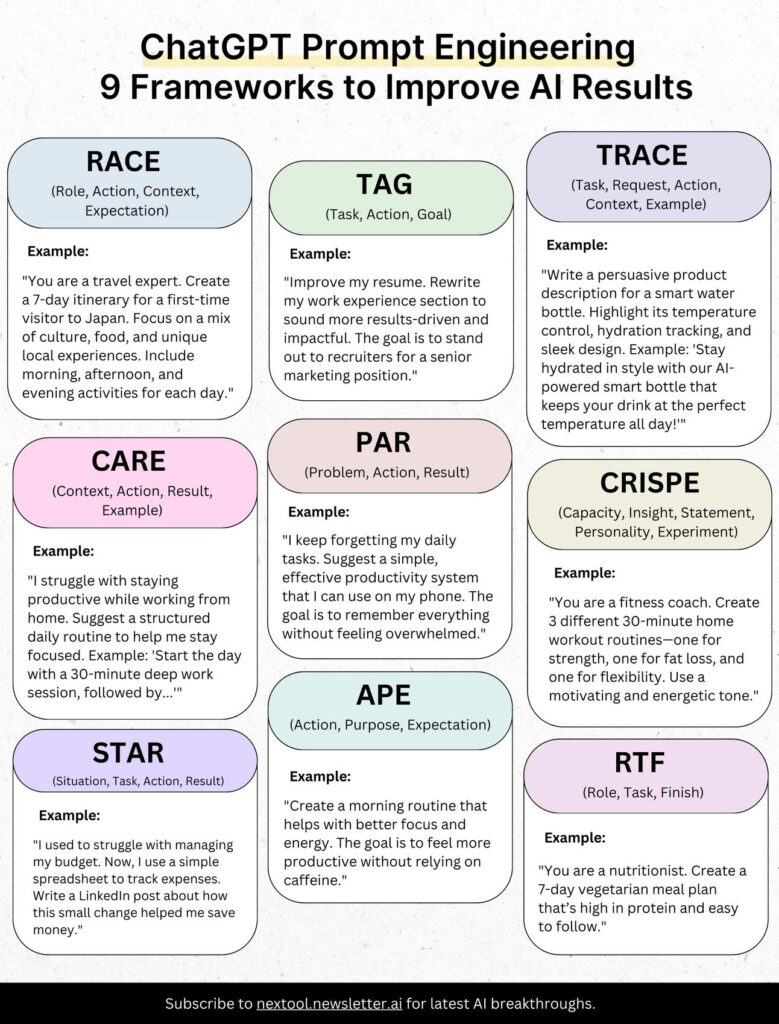In my decade-long journey exploring artificial intelligence, I’ve watched prompt engineering evolve from a curious experiment to an essential skill. Let’s be honest—getting AI to produce exactly what you want can feel like trying to explain a complex recipe to someone who’s never set foot in a kitchen. But fear not! I’ve discovered some brilliant frameworks that’ll help you craft the perfect prompt every time.
The Evolution of Prompt Engineering
According to last month’s fascinating State of Open Source AI report by Weights & Biases, a whopping 78% of AI practitioners cite prompt engineering as their biggest challenge. That’s not surprising… We’ve all been there, haven’t we? You ask ChatGPT something simple and get a response that makes you tilt your head and go “Really mate?”
Breaking Down the Frameworks
Let’s dive in.
RACE: Your AI Travel Companion
Think of RACE (Role, Action, Context, Expectation) as your AI’s GPS. I recently used this framework to plan a trip to Edinburgh—instead of getting generic tourist spots, I received a beautifully curated experience. The magic lies in the details. By specifying the role (travel expert), action (create itinerary), context (first-time visitor), and expectations (mix of history and modern culture), you’re essentially giving your AI a crystal-clear roadmap.
TAG: Straight to the Point
TAG keeps it simple. Three words that matter: Task, Action, Goal. I love this one. It works.
TRACE: The Show-and-Tell Framework
TRACE (Task, Request, Action, Context, Example) is like having a conversation with a really attentive friend. By including examples, you’re showing the AI exactly what success looks like—brilliant for creative tasks.
PAR: Problem-Solving Made Simple
This one’s my favourite for tackling everyday challenges. PAR (Problem, Action, Result) is straightforward but effective—like a good cup of tea.
CARE: The Empathy Framework
Context, Action, Result, Example—CARE helps you get responses that feel more… human. It’s particularly useful when you need nuanced, thoughtful answers.
APE: Morning Routines and Beyond
Action, Purpose, Expectation—perfect for lifestyle and productivity prompts. I’ve used this framework to completely revamp my morning routine—no more hitting snooze six times!
STAR: The Storyteller’s Framework
Situation, Task, Action, Result—brilliant for crafting compelling narratives. It’s like having a mini-template for success stories.
CRISPE: The Creative’s Companion
This framework is a bit more complex—but that’s what makes it special. It’s particularly useful for creative tasks that need a specific tone or personality.
RTF: Keep It Moving
Role, Task, Finish—sometimes simpler is better. RTF is perfect when you need quick, focused results.
Making It Work for You
Here’s the thing—these frameworks aren’t rigid rules. They’re more like… recipe guidelines. You wouldn’t hesitate to add extra garlic to your favourite dish, would you? Similarly, feel free to adapt these frameworks to suit your needs.
I’ve found that mixing and matching elements from different frameworks often yields the best results. Sometimes you might want the role-based approach of RACE with the example-driven clarity of TRACE. That’s perfectly fine—brilliant, even!

Looking Ahead
As AI continues to evolve—and believe me, it’s evolving at a dizzying pace—these frameworks will likely evolve too. But the fundamental principle remains: clear communication gets better results.
Remember this: AI is your partner, not your servant. Treat it like a clever colleague who needs clear, well-structured instructions, and you’ll be amazed at what you can achieve together.
What’s your experience with prompt engineering? Have you tried any of these frameworks? I’d love to hear your thoughts in the comments below!




